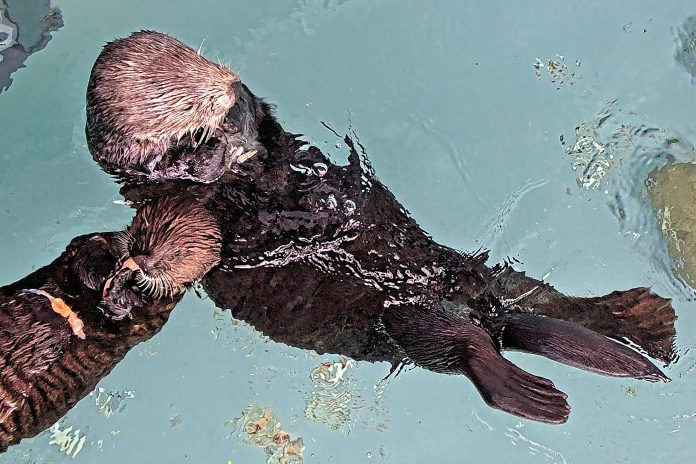
The Aquarium of the Pacific is welcoming a female orphaned sea otter pup, which was rescued off the coast of Santa Cruz County. This baby sea otter is the first surrogate-raised otter at the Aquarium of the Pacific, for potential release back to the wild, as part of a partnership with the Monterey Bay Aquarium Sea Otter Surrogacy Program. The pup is paired with an adult female sea otter at the Aquarium of the Pacific with the goal of being able to learn from her the survival skills needed to be able to return to the wild. These vital skills include foraging for food and grooming their thick fur to thrive in cold water temperatures.
Since it opened in 1998, the Aquarium of the Pacific has been providing a home for rescued sea otters deemed non-releasable to the wild by the U.S. Fish and Wildlife Service. “We are thrilled to be able to further help this threatened species recover by expanding our conservation programs to now help stranded sea otter pups get a second chance at returning to the wild,” says Brett Long, Aquarium of the Pacific senior director of birds and mammals. The Aquarium of the Pacific joined Monterey Bay Aquarium’s Sea Otter Surrogacy Program as a partner in 2020. As part of this partnership, the Aquarium of the Pacific built a behind-the-scenes facility for the surrogate mothers and these orphaned pups.
“We’ve been working with our partners at the Aquarium of the Pacific for more than three years to reach this moment, and we’re excited they’re now ready to welcome orphaned pups for surrogacy,” said Jessica Fujii, manager of the Sea Otter Program at Monterey Bay Aquarium. “Sea otters help maintain the health of kelp forests and wetlands on California’s coast. This milestone is advancing our work to help sea otters recover from being hunted to near extinction and help strengthen our coastal ecosystems.”
The surrogacy area at the Aquarium of the Pacific was built behind the scenes of its Molina Animal Care Center and will be able to accommodate three to four rescued sea otter pups each year. The pups will be away from public view to limit human interaction to increase their chances of surviving on their own in the wild. Videos of rescued pups and signage located outside of the surrogacy facility will help educate the Aquarium’s visitors on the surrogacy program and the significance of recovering southern sea otter populations. A grant from the California’s State Coastal Conservancy Sea Otter Recovery Grant Program supported the initial construction of the sea otter surrogacy facility.
The Aquarium of the Pacific also has a public fundraising campaign to support its work with rescued sea otter pups through this program. Anyone interested in getting involved and providing support of this important conservation work can visit pacific.to/saveseaotters and make a gift online or call (562) 951-1701.
Southern sea otters (Enhydra lutris nereis) are marine mammals in the weasel family. They are currently found along the North American west coast from Half Moon Bay just south of San Francisco to Point Conception in Santa Barbara County, a fraction of their historical range. Sea otters play the important role of ecosystem engineer for their ocean habitats. Sea otters were hunted to near extinction in the early 1900s. Now a protected species, California’s sea otters have grown from a group of fifty in 1938 to nearly 3,000 today. Despite this progress, their population growth has stalled in recent years and they continue to face serious risks, including oil spills, pollution, and climate change.
Through its Pacific Visions area, visitors to the Aquarium of the Pacific can learn how climate change is impacting the ocean, its inhabitants, and people, along with what can be done to work toward a more sustainable future. The Aquarium also serves as a facility for rehabilitating and releasing sea turtles, raising endangered mountain yellow-legged frogs for release, and spawning and releasing endangered white abalone.
The nonprofit Aquarium of the Pacific is a community gathering place where diversity and the arts are celebrated and where important challenges facing our planet are explored. The Aquarium is dedicated to conserving and building nature and nature’s services by building the interactions between and among peoples. Home to more than 12,000 animals, Aquarium exhibits include the Southern California Gallery, Pacific Visions, and Shark Lagoon. Beyond its animal exhibits, the Aquarium offers educational programs for people of all ages, including First Wednesdays featuring a variety of guest speakers. The Aquarium offers memberships with unlimited FREE admission for 12 months and other special benefits. To make a donation to help support the Aquarium, please visit pacific.to/donate. To visit, reservations are required for everyone and can be made at aquariumofpacific.org or by calling (562) 590-3100.